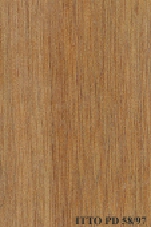
VIROLA (Virola reidii)
Trade Name
Virola
Scientific Name
Virola reidii Little
Family
MYRISTICACEAE
Common Names
Cumala Blanca (Peru); Pintri (Surinam); Cumala (Peru); Moulomba (Guyana); Shempo (Ecuador); Chaliviande (Ecuador); Nuanamo (Colombia); Sebo (Colombia); Ucuuba (Brazil); Colorado; Camaticaro (Venezuela); Otivo (Venezuela); Baboen (Surinam); Cajuea (Trinidad & Tobago); Cuajo (Venezuela); Palo De Sangre; Sangrino (Venezuela); Cumala Colorada (Peru); Sangre; Birma; Bicuiba Branca (Brazil); Yayamadou (Guyana); Ucuhuba (Brazil); Virola (Brazil); Tapsava; Dalli (Guyana); Banak; Ucuuba Vermelha (Brazil); Virola (Ecuador); Nuánamo (Colombia); Otobo (Colombia); Sebo (Colombia)
Description Of The Tree
Botanical Description
This species attains an average height of 30 m, and an average trunk diameter over the buttresses of 60 cm. The tree usually develops a straight and clear bole with commercial lengths of 15 m.
Natural Habitat
Virola reidii is found in the tropical rain forests. It is also found in the "guandal" forests in the Pacific coasts of Colombia.
Natural Distribution
V. reidii is reported to grow in Brazil, Colombia and Ecuador.
Wood Identification
Anatomic Description Of Wood
Wood diffuse porous. Vessels solitary and in short radial multiples. Tangential diameter of vessel lumina 200 micras or more (large). Vestured pits. Vessels per mm2 less than 6 (rare). Simple perforation plates. Scalariform perforation plates with 5 bars or les Axial parenchyma absent or extremely rare, non visible with magnifying glass (8x). Paratracheal axial parenchyma scanty and/or vasicentric. 4 to 10 rays per mm (medium). Rays 1 to 4 seriate. Body ray cells procumbent with mostly 2 to 4 rows of upright and/or square marginal cells (Kribs-II). Fibers very thin walled. Occasionally septate fibers present. Fibers with simple to minutely bordered pits. Fibers storied.
-
 Wood Macro Photo Tangential Plane
Wood Macro Photo Tangential Plane
Availability
Cites Status
Unrestricted
General Wood Description
Odor
It has a typical aromatic smell when freshly cut.
Color
The sapwood is pinkish white, changing gradually into pale brown
COLOR INDEX (1=Black, 7=Light yellow,white)
4
Grain
Straight grain is reported in this species.
Texture
The wood is mostly coarse in texture.
Luster
Luster is reported to be moderate.
Natural Durability
It is easily attacked by fungi or termites. It is reported to be also attacked by Lyctus.
Natural durability index (1= Very high durability, 7=Vey low durability)
5
Resistance To Impregnation
This species is reported to be easy to preserve.
Wood Physical Properties
Basic Density or Specific Gravity (O.D. weight/vol. green) (g/cm³)
0.45
Air-dry Density (Weight and volume at 12%MC) (g/cm³)
0.48
Total shrinkage Tangential (Saturated to 0%MC) (%)
10.5
Total shrinkage Radial (Saturated to 0%MC) (%)
5.6
Drying Defects
Ease of Drying: It is reported to be easy to air and kiln dry.
Recommended Dry Kiln Schedule
UK-C; US-T3-C2; JUNAC-A
Dimensional stability ratio (Total Tangential Shrinkage %/Total Radial Shrinkage %)
1.9
Wood Chemical Properties
Wood Mechanical Properties
Bending Strength (MOR),12%MC (kgf/cm²)
1080
Stiffness (MOE) 12%MC (kgf/cm²)
154000
Compression parallel to fiber 12%MC (kgf/cm²)
475
Shear strength radial 12%MC (kgf/cm²)
92
Janka hardness (side) 12%MC (kgf)
385
Workability
Sawing
Sawing of this species is reported to be rather easy.
Rotary Veneer Cutting
Lamination of this species is possible.
Sliced Veneer
Lamination of this species is possible.
Machining
Wood processing is reported to be easy.
Planing
Planing of this species is reported to be easy.
Moulding
Molding is reported to be easy.
Boring
It is easy to bore.
Sanding
It is easy to sand.
Finishing
This species is reported to be easy to finish.
Response To Hand Tools
This species is easy to work with hand tools.
REFERENCED USES
End Uses Summary
HOUSING GENERAL, joists, boards, fittings, PLYWOOD AND VENEER, PACKING, OTHER AND MUSICAL INSTRUMENTS, handicrafts, moldings
General Housing
- 10 - Silica in Timbers
Joists
- 12 - Tropical timbers of the world. Part I-Tropical American Species
Boards
- 13 - Dry kiln schedules for commercial woods. Temperate and tropical. Section III. Latin American (Mexico, Central, and South America) Woods–Conventional Temperatures
Fittings
- 19 - Silica in Timbers
Panels, Veneers
- 25 - Directory of Timber Trade Malaysia
Packing
- 45 - Recopilación y Análisis de Estudios Tecnológicos de Maderas Peruanas
Handcraft
- 66 - Maderas latinoamericanas. VII. Caracteristicas anatomicas. propiedades fisicomecanicas, de secado, y tratabilidad de la madera juvenil de Cordia alliodora (Ruiz & Pav. Oken.)
Molding
- 79 - Padronização da Nomenclatura Comercial Brasileira das Madeiras Tropicais Amazônicas, Sugestão
Please Provide Information To View Producer Information